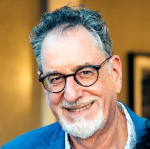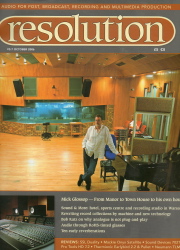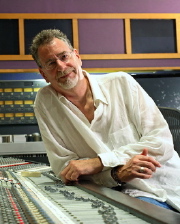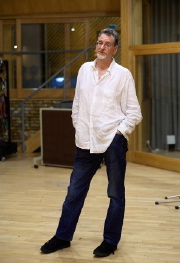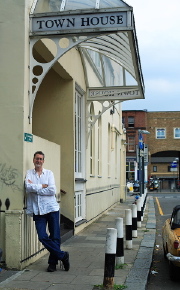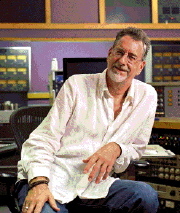He was in on the ground floor at two of the most influential studios that marked what is acknowledged as the birth of the modern recording era yet he still retains the passion and enthusiasm that influenced a generation of engineers who sat beside him. Mick Glossop talks to niGel Jopson about quadraphonic pan pots, the first ssl, and inspiring musicians.
Mick Glossop’s name is synonymous with two benchmark UK recording studios of the late 1970s and early 1980s — the Richard Branson-owned Manor and Town House — and he was chief engineer at both. Mick worked with many of the legendary early Virgin Records acts including Kevin Coyne, Mike Oldfield (Orchestral Tubular Bells) and Tangerine Dream, for whom he recorded and mixed the groundbreaking Rubycon and later Ricochet albums.
He went on to work with an influential array of new wave and post-punk stars including The Ruts, Penetration, The Skids, The Alarm, Tubeway Army, Gary Numan and Public Image (who’s eponymous debut album he recorded and mixed). Glossop developed something of a reputation as an audio guru, as many of the assistants and engineers who worked in his studios went on to become well known producers and engineers in their own right, among their number Alan Douglas and Steve Power. Mick moved on to form successful and enduring partnerships as a producer with bands like The Waterboys, Furniture and The Wonder Stuff. Never one to rest on his laurels, Glossop continued to work with bands so cutting edge their talents sometimes slid between the cracks, such as Lower (The Gentle Art of Conditioning) and Shin Hae Chul’s arty N.E.X.T., as well as finding time to form a productive late-album affiliation with Lloyd Cole.
The most defining landmark in Mick’s career must surely be his long association with Van Morrison, having recorded and mixed 15 of the Irish troubadour’s albums, and had his fingers on the faders of practically every tune the prolific songsmith has written. Resolution interviewed Mick at the Town House, on the day of the legendary facility’s official closure, as he awaited the completion of an Andy Munro-designed studio in the basement of his own Townhouse.
You have such a wide ranging career, are there any milestones you could single out?
I’m lucky to have worked with at least two artists of whom I was a great fan, Frank Zappa and Van Morrison. I’d listened to their albums and bought their records several years before I worked with them. I was still chief engineer here at the Town House when I first worked with Zappa. I was recording an album he was producing for an Indian violinist by the name of L Shankar, a virtuoso prodigy who’d crossed over to rock through playing with John McLaughlin. That was my introduction to Frank, I just got the gig through being in the right place at the right time. He then asked me to record four live shows at the Hammersmith Odeon on the Rolling Stones mobile, which was fun — the RSM was the original truck built in the UK and had quite a modest Helios desk — this was a Frank Zappa show, with percussion players, four guitarists, drummers and lots of singers! Later on, when Frank was recording Joe’s Garage, I was in California at the Record Plant recording Into The Music with Van. I got a call from Zappa to say ‘How much time have you got? We’ve got a triple album to mix!’ I had ten days so I went down to LA and mixed three sides, Steve Nye ended up doing the last three. Zappa had a house in the hills with a very well equipped studio with a large Harrison desk. The air conditioning broke and it became ridiculously hot, so we ended up mixing at Kendun Studios Burbank. They had an early SSL B series, which I was pleased about as I’d been working on the same system at the Town House. I was keen to demonstrate my chops on this new system and show Frank how great it was — but the automation was broken! I heard a story later on that the tech engineer at Burbank had been impressing his mates by getting into the software and tweaking stuff, and in the process had completely screwed up the computer’s operating system. Joe’s Garage is a long track, so we had to mix it in sections by hand, with lots of chalk marks on the faders and half-inch edits.
I hear you’re mixing all of Van Morrison’s archive material for a boxed set.
The boxed set is an ongoing project. A huge amount of tape arrived from the US at the Wool Hall studio about 15 years ago. They were recordings from all the sessions Van had ever done, presumably during the entire Warner period. Some of the material was mixed immediately and came out as the Philosopher’s Stone album, pretty much everything else has been mixed by now, I’ve spent a fair amount of time doing that. It was extremely enjoyable, there were some great bands, great playing and performances. It was fabulous fun to work on, the tape was running all the time during most sessions, so you get the atmosphere and chat from the time. A lot of the tapes were not labelled, so a lot of detective work went on. Fortunately Van’s memory is incredible, he was right there with all the names of people he’d played with 30 years ago.
Van’s Inarticulate Speech Of The Heart album was recorded here at The Town House, wasn’t it?
We spent six days in the old Studio 2, which doesn’t exist any more, I think we recorded 12 or 13 songs including Rave On John Donne.
So can you now exclusively reveal to Resolution readers the existence of an extended studio version of John Donne?
It’s one of the longest tracks Van has recorded in the studio, 32 minutes or something — we had to change the tapes in the middle of it — or maybe we had two machines running, I can’t quite remember. A lot of editing went on. But that’s what happens with free improvisation, which is what largely developed in that song. That’s a particular type of Van Morrison song which starts out as a sheet of lyrics and some melodic ideas on his part, but basically nobody knows what’s going to happen.
You always had a bit of a reputation for pushing the boundaries. Dave Ruffy [of the Ruts] said that you: ‘used recording techniques which were ahead of their time.’
That’s very nice of him! ... it’s just a matter of looking for new things. There’s such a lot of music out there, you have to think in terms of making records that have got something original. It’s a very English thing, to always think about being original. If you can create something sound-wise that is happening then that in turn inspires musicians. If you make something sound a certain way, which they didn’t expect, then that can stimulate a certain sort of performance. When the record-buyer hears a song, it’s the performers they’re listening to. People I know who aren’t in the industry don’t talk to me about sound ... you’ve got to do something very extreme sonically with a record for the average bloke in the street to say: ‘ooh, that sounds different.’ They’re listening to the instrumentalists and singers, that’s what gets through to them, so that’s what you have to spend a lot of time stimulating if you are producing a record.
Most good engineers and producers have this sort of maverick idea — let’s turn the knobs up all the way (I know we’re not supposed to) — let’s see what it sounds like. Sometimes you abuse the equipment ... it’s a creative process, you want to do something new all the time. I deliberately look for new ways to mic up drum kits these days, because I’ve recorded so many conventionally close-miked kits.
Which new system have you arrived at now with the drums?
The last recording I made I used two kick drum mics, one top snare mic, one overhead ... the hi-hat mic was about 10 feet away ... some room mics in funny places and no close microphones over the toms. You have to be aware and stop doing things when you fi nd yourself doing them automatically. When you have the time to experiment as an engineer, I think you have to deliberately steer yourself away from the techniques you know will work, to force yourself to do something different.
Do you insist on an analogue console nowadays, or do you use a worksurface?
Well — I’ve probably mixed seven or eight albums completely inside Pro Tools. I haven’t used a Pro Control, although it’s something I might end up getting for my own studio.
Are you a balance person rather than a radical EQer?
Yes, it’s like playing an instrument, you can do so much more by just moving a fader a quarter of an inch. Once you realise that potential ... I’m looking for those tweaking opportunities all the time when I am mixing. I hardly do any offl ine mix joins. But with Pro Tools I do a little tweaking with the mouse on vocals. I never thought I’d work that way, because I always believed vocal rides were a feel thing. But in fact you can do much more precise work, for example for de-essing a vocal. However, you always have to be mindful of the fact that, as humans, visual information seems more powerful than the ear, and be wary of tweaking a waveform just because it looks louder. For example, I much prefer EQ plug-ins that don’t display a curve, it is too influential.
It is possible that your studio will just consist of a DAW and some mic pres?
I think these things are still evolving, but sonically it is possible to get very good results working completely in-the-box. Even without using external analogue gear, there are several plug-ins, which I’ve spent a lot of time researching, that help you on the way. But the only reservation I have about working in-the- box, even though you may end up with a very good sonic result, is that it’s not a lot of fun. It’s rather like hard work! As my own studio gets going, it’s a major decision I have to make: do I bus out on 24 submixes, with or without automation? It’s a big topic of debate at the moment, whether you need to sum in the analogue domain. I’m not really sold on the arguments in favour, but I’m going to wait until I get a stable listening environment and have the opportunity to make my own extensive listening tests.
Do you think it’s essential for today’s producers to have a studio of their own, do bands and labels expect it?
Not from my experience, but I’ve always wanted one! I’m expanding my house and creating a basement, I’ll have a booth, I might even be able to get a small rhythm section in there. There are a lot of projects I’d like to work on, very interesting projects, that are probably not going to have the budgets to allow me to rent the modern version of the Town House. That’s a major reason for setting my own studio up, it will mean I can just work on projects I’m attracted to from a purely creative point of view. This question of what is going to be successful in the future ... the whole model of how artists are signed to record companies and have their albums financed is changing completely. Now it’s possible for people to make records without spending humongous amounts of money. I’m quite happy to work for a much lesser fee — which is compensated for by a different kind of royalty structure or something — that’s the sense in which a producer really needs to own a facility.
Did you start with a fantasy idea of your perfect listening room?
Not really, because I only had the space: 40 square metres! It’s just a question of sitting down and thinking — what is the best way to use this? I’m probably spending more money on the acoustics than anything else in my studio, actually. Andy Munro has designed the soundproofi ng, which is essential because I live in an Edwardian terraced house, and he is doing the acoustic treatment, which is basically going to be a series of panels about 200mm deep. I didn’t give him a brief, because he is the expert as far as I am concerned. I believe in hiring experts and then listening to what they tell you.
Is the era of the large Town House-style facility over?
We are not going to have the same number of big studios around — look at the Scissor Sisters, they recorded themselves in a fl at in New York, straight into Logic — their record sounds great, what can you say? If you think back to the late 1940s, in the formative years of Atlantic Records, Tom Dowd would clear the desks at Atlantic’s office building and record great songs on 4-track or whatever. I’ve recorded lots of albums on location with mobile rigs, which undermines the notion that you have to have a big expensive studio.
What inspires you? Is it still the reference point of the musicians playing in the room?
That and a sense of arrangement. It’s not just a matter of reproducing what’s happening in the room. We are making records, we aren’t making recordings. What inspires me is still that thing of what makes a record sound great — not just sonically, but impact, emotional communication, expression — all of those things are still there.
Mick Recalls His Time as chief engineer at The Manor and Town House:
‘When I was at The Manor in 1976 I’d only been engineering for around four years — I was still learning — in fact, I’m still learning now! The Manor had a unique atmosphere; the recording studio had been there since around 1970, built for Richard Branson by Tom Newman. it worked fine for what they had been doing, but by 1976 it had become a bit tired. Initially The Manor attracted a lot of heavy clients, because it was such a great place to visit. But I don’t think many of them came back, as it was a bit funky, technically.
Richard wanted to rejuvenate his studio, Phil Newell (Manor technical director) managed to prise a pretty good budget out of him. We got great gear, a quadraphonic monitoring system, lots of toys, and an automated mixing system with the new allison 65k programmer.
Redesigning The Manor: ‘Phil had met acoustic designer Tom Hidley in the states, Tom was interested in moving to europe and had already designed Mountain studios in Montreux. He’d worked at the Record Plant and developed his own system for a comprehensive studio monitoring design, which appealed to us. Prior to that, an acoustician might design a control room, then the owners would choose the loudspeakers and hang them up on the walls, there was no integration. Tom was the guy who came in and said: “You can’t separate the two, they work together.” it wasn’t a conscious attempt by us to be cutting edge, we just wanted it to be really good, and Phil and myself had been given the freedom to do just that, it was a great feeling.
At the Manor we put a Helios console in. Helios was a UK company that only made custom consoles so it was fantastic — you could have whatever you wanted — I had quad panning joysticks on every channel! in those days of discrete input channels and group outputs the tape monitors were not used during mixes. so I requested that Dick Swettenham (the Helios designer) find some way of routing them to the mix as extra inputs. it was a good team of people and the studio was managed extremely well by Barbara Jeffries. It was really successful on the basis of that — so Richard decided — “I think I’d like a London studio ... would you like to get on with that now?”
The Town House: The spec was for two rooms, so we started creating our wish list of equipment. We decided to put another Helios console in studio 1, but for studio 2 we wanted something different ... it was that idea of offering clients a choice. At the time there were Neve, Cadac, MCI and Harrison as headline contenders. Although they all made good consoles, neither Phil or I were terribly knocked out with the idea of having any of them. We must have spent six months sitting around the kitchen table at the Manor saying “We’ve got everything else sorted out, what are we going to install in control room two?” A guy called John Romer did the weekend maintenance at the Manor, his day job was at nearby acorn studios in Stonesfield. John had been rabbiting on about this console at Acorn — we kept saying “Yeah, yeah John (never heard of these people) please go away!” But in the end we thought we should really go and check it out, so we all went to meet Colin Sanders.’
Solid State Logic innovation: ‘Colin explained the channel strip he had designed, everything was in the right place. We take it for granted now, but one of my main complaints about Neve then was that, ergonomically, nothing sat right in the channel strip: you had to stand up to reach for some adjustments. Colin started to talk about compressors and gates on every channel, and the tape remote in the centre and tape monitoring switches on every channel. This was revolutionary at the time, there weren’t any console manufacturers who had even thought of that. Colin invented the Supercue, where the musician could listen to what he had just played, play along and hear the combined mix just before you got to a punch-in point. After working at his own Acorn studio, Colin thought that would be good and just built it in ... to me it’s a revolutionary idea that we now take for granted.
And Autocue: you stop the tape and talkback comes on. Such a simple idea, but nobody had done it. By this time I was pretty much sold on the new mixer ... then he started talking about the automation system! We had been used to using the Allison, or similar tape-based automation systems, where the time delay between successively updated mixes was silly. You always had to redo the cuts at the very end or they came in late. Here was Colin’s delay-free system that was tied to a SMPTE timecode. You could keep all the mixes — it worked! — and it was an autolocator as well. This was a mega-leap forward at the time. We had the first SSL in the UK and I became a real advocate of the system.’
On the famous ‘In The Air Tonight’ Town House drum room: ‘I can remember having a conversation with Phil Newell about that room: “What are we going to do with this, it’s pretty live in here, doesn’t it need some treatment?” Phil said: “Basically, we’ve run out of money. Let’s just see what happens, and if we need to do anything with it then we’ll deal with that on the next budget.”
Resolution Oct 2006
(Photos www.recordproduction.com)
